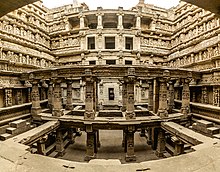Bhima I
Bhima left his capital and took shelter in Kanthkot during this invasion, but after Mahmud's departure, he recovered his power and retained his ancestral territories.
[2] Early during his reign, Bhīma faced an invasion by Mahmūd of Ghazni, whose plunder of the Somnāth temple has been described in detail by the medieval Muslim historians.
He left Multan on 26 November, with a large army well-equipped to cross the Thar desert, and reached the Chaulukya capital in December 1025 CE.
Mahmūd's sudden invasion, coupled with the lack of any fortifications in Nahrwāla, may have forced Bhima to abandon his capital.
Other residents of the city also appear to have evacuated it, as the Muslim historians do not mention any massacre or looting in the Chaulukya capital.
[7] Mahmūd then desecrated the temple, and looted a huge amount of wealth including jewels and silver idols.
[8] During his return journey, Mahmūd came to know that a powerful Hindu king named Param Dev had gathered a large army to fight him.
Gardezi, in his Kitab Zainu'l-Akhbar (c. 1048 CE), states that Mahmūd chose to avoid any confrontation with this king.
The invader was carrying back a large amount of looted wealth, which may have motivated him to avoid a battle.
[9] The 16th century historian Firishta identified Param Dev with Bhīma I, calling him the king of Nahrwāla.
[10] Scholars who are critical of this theory identify Param dev with the Paramara king Bhoja, who ruled the neighbouring territory of Mālwa.
K. N. Seth and Mahesh Singh point out that Bhīma had ascended the throne recently, and was not a powerful ruler at the time of Mahmud's raid.
Bhoja was also a Shaivite, and according to the Udaipur Prashasti, had constructed a temple dedicated to Somanātha (an aspect of Śiva).
[11][12] According to the 12th century scholar Hemacandra, who was patronized by the Caulukyas, Bhīma defeated Hammuka, a ruler of Sindh.
[14] Vimala commissioned the shrine of Adinātha at Mount Abu in 1031 CE, so Dhandhuka's rebellion must have happened before this year.
[19] Bhima formed an alliance with the Kalachuri king Lakshmi-Karna, and played a significant role in the downfall of Bhoja, the Paramara dynasty of Malwa.
Damara instigated Bhoja to attack the Chalukyas of Kalyani, who had killed the earlier Paramara ruler Munja.
While Bhoja was facing a war with the Kalyani Chalukyas, Damara lied to him that Bhima had also started a march against him.
[20] Merutunga further states that while Bhima was engaged in a war against the king of Sindh, Bhoja's digambara general Kulachandra sacked the Chaulukya capital Anahilapataka.
One day, while Bhoja was worshipping his family deity at a temple on the outskirts of his capital Dhara, the goddess warned him that he was surrounded by enemy soldiers.
[22] One particular chronicle Kirti-Kaumudi claims that Bhima captured Bhoja, but generously released him and spared his life.
The 12th century writer Hemachandra claims that Bhima sent his ambassador Damodara to Karna, demanding his share of the Paramara assets.
The 14th century chronicler Merutunga claims that Bhima demanded half of Bhoja's kingdom from Karna.
[24] These accounts by the Chaulukya chroniclers appear to be historically inaccurate, as Karna was too powerful to be subdued by an ambassador of Bhima.
It is possible that Bhima gained some advantage over Karna, after the Kalachuris were decisively defeated by the Kalyani Chalukya king Someshvara I.
Historian A. K. Majumdar theorizes that Merutunga's account appears to be more accurate, since voluntary rejections of thrones were very rare.
Hemachandra, who was a royal courtier, probably wanted to avoid mentioning the illegitimate son Haripala, and therefore, glossed over the genealogy.
Bhaktamarastrotra Vritti (1370 CE) and Ratnamandira's Upadeshatarangini (c. 15th century) mentions the construction of Adinatha and Parshwanatha temples by Shreshthi Jhinah at Dhavalakka (Dholka) during this period.
The vase-and-foliage pillars and lintels of a temple of this period at Patan is reused in the inlet sluice chamber of Khan Sarovar.
The Tanka Mosque in Dholka has four decorated bhadraka pillars reused from a small shrine of this age.



